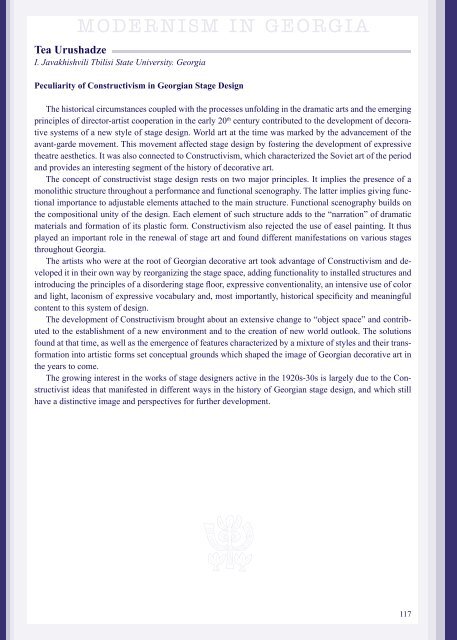Abstracts - International Initiative for Georgian Cultural Studies
Abstracts - International Initiative for Georgian Cultural Studies
Abstracts - International Initiative for Georgian Cultural Studies
You also want an ePaper? Increase the reach of your titles
YUMPU automatically turns print PDFs into web optimized ePapers that Google loves.
MODERNISM IN GEORGIA<br />
Tea Urushadze<br />
I. Javakhishvili Tbilisi State University. Georgia<br />
Peculiarity of Constructivism in <strong>Georgian</strong> Stage Design<br />
The historical circumstances coupled with the processes unfolding in the dramatic arts and the emerging<br />
principles of director-artist cooperation in the early 20 th century contributed to the development of decorative<br />
systems of a new style of stage design. World art at the time was marked by the advancement of the<br />
avant-garde movement. This movement affected stage design by fostering the development of expressive<br />
theatre aesthetics. It was also connected to Constructivism, which characterized the Soviet art of the period<br />
and provides an interesting segment of the history of decorative art.<br />
The concept of constructivist stage design rests on two major principles. It implies the presence of a<br />
monolithic structure throughout a per<strong>for</strong>mance and functional scenography. The latter implies giving functional<br />
importance to adjustable elements attached to the main structure. Functional scenography builds on<br />
the compositional unity of the design. Each element of such structure adds to the “narration” of dramatic<br />
materials and <strong>for</strong>mation of its plastic <strong>for</strong>m. Constructivism also rejected the use of easel painting. It thus<br />
played an important role in the renewal of stage art and found different manifestations on various stages<br />
throughout Georgia.<br />
The artists who were at the root of <strong>Georgian</strong> decorative art took advantage of Constructivism and developed<br />
it in their own way by reorganizing the stage space, adding functionality to installed structures and<br />
introducing the principles of a disordering stage floor, expressive conventionality, an intensive use of color<br />
and light, laconism of expressive vocabulary and, most importantly, historical specificity and meaningful<br />
content to this system of design.<br />
The development of Constructivism brought about an extensive change to “object space” and contributed<br />
to the establishment of a new environment and to the creation of new world outlook. The solutions<br />
found at that time, as well as the emergence of features characterized by a mixture of styles and their trans<strong>for</strong>mation<br />
into artistic <strong>for</strong>ms set conceptual grounds which shaped the image of <strong>Georgian</strong> decorative art in<br />
the years to come.<br />
The growing interest in the works of stage designers active in the 1920s-30s is largely due to the Constructivist<br />
ideas that manifested in different ways in the history of <strong>Georgian</strong> stage design, and which still<br />
have a distinctive image and perspectives <strong>for</strong> further development.<br />
117



